USB Flash Drive vs External Hard Drive Your Complete Comparison Guide
You want to pick the best data storage device for you. Choosing between a usb flash drive and an external hard drive depends on what you need most. If you want something small to move files fast, a usb flash drive is very handy. If you have big files or need to back up often, an external hard drive gives you more space and faster speeds. Think about how easy it is to carry, how much it can hold, how fast it works, how tough it is, the cost, and what you will use it for before you choose. If you ask, What is a USB Flash Drive?, this guide will help you decide.
Key Takeaways
USB flash drives are very small and easy to carry. You can put them in your pocket or on a keychain.
External hard drives can hold much more data. They are good for saving backups and big files.
External SSDs are the fastest for moving files. USB flash drives are good for quick file transfers.
USB flash drives do not have moving parts. This makes them stronger if you drop them or bump them.
External hard drives are cheaper for each gigabyte. They are a better deal if you need lots of space.
Use USB flash drives for small files and presentations. They are great for sharing things quickly when you travel.
Pick external hard drives for safe long-term storage. They are good for keeping big music or movie collections.
Always save copies of important files. Use encryption to keep your data safe on both devices.
Quick Comparison

Table Overview
Feature | USB Flash Drive | External Hard Drive |
|---|---|---|
Portability | Ultra-portable, fits in your pocket or on a keychain | Portable but larger and heavier |
Storage Capacity | 16GB to 1TB (most common: 32GB-256GB) | 500GB to 18TB (most common: 1TB-5TB) |
Speed (MB/s) | Up to 400 (USB 3.2 models) | 80 - 160 (HDD); 400 - 2000 (SSD models) |
Durability | Solid-state, shock-resistant, some waterproof | Mechanical parts, more prone to drops |
Price (per GB) | Moderate, higher for large sizes | Lower for HDDs, higher for SSDs |
Use Cases | Quick file transfers, presentations, boot drives | Backups, large file storage, media libraries |
Tip: If you want to carry files in your pocket, a USB flash drive works best. If you need to store lots of photos, videos, or backups, an external hard drive gives you more space.
Key Specs
Portability:
You can slip a USB flash drive into your pocket or attach it to your keys. Most models weigh less than an ounce. External hard drives are still portable, but they take up more space in your bag and weigh more.Storage Capacity:
USB flash drives usually offer between 16GB and 1TB. High-capacity models cost more. External hard drives start at 500GB and can go up to 18TB. You get much more space for your money with an external hard drive.Speed:
USB flash drives with USB 3.2 can reach speeds up to 400 MB/s. External hard drives with spinning disks (HDDs) usually transfer data at 80-160 MB/s. If you choose an external SSD, you can get speeds from 400 MB/s up to 2000 MB/s. For big files or lots of data, external SSDs work much faster.Durability:
Flash drives use solid-state memory, so they resist shocks and drops. Some models are waterproof or crush-resistant. External hard drives have moving parts inside. They can break if you drop them. SSD models are tougher than HDDs.Price:
You pay more per gigabyte for a USB flash drive, especially for larger sizes. External hard drives, especially HDDs, give you more storage for less money. SSD external drives cost more but offer better speed and durability.Use Cases:
Use a USB flash drive for quick file transfers, sharing documents, or running a portable app. Choose an external hard drive for backing up your computer, storing large media files, or keeping a big photo library.
Note: If you need to plug and unplug your device often, USB flash drives handle about 1,500 insertions before wearing out. External hard drives do not have this limit, but their moving parts can wear down over time.
What is a USB Flash Drive?
USB Flash Drive Basics
If you have ever wondered, what is a usb flash drive?, you are not alone. A usb flash drive is a small, portable device that stores digital files. You plug it into a computer’s USB port to move, save, or share data. Most usb flash drives use solid-state memory, which means they have no moving parts. This makes them reliable and fast for everyday use. You can find usb flash drives in many shapes and sizes, from tiny sticks to larger, rugged models. They support different USB versions, such as USB 2.0, USB 3.0, and even USB-C. These versions affect how quickly you can transfer files. The answer to what is a usb flash drive? also includes its ability to work with different file systems like FAT, NTFS, and exFAT. These file systems help organize your files and make sure your device works with many computers.
Tip: You can use a usb flash drive on almost any computer, making it a universal tool for students, professionals, and anyone who needs to move files.
Features
When you look at what is a usb flash drive?, you will notice several key features. First, portability stands out. You can slip a usb flash drive into your pocket or attach it to your keys. Durability is another strong point. Because it uses solid-state memory, it resists shocks and drops better than devices with moving parts. Some models are even waterproof or crush-resistant. Storage size varies, with most usb flash drives offering between 16GB and 1TB. High performing flash drives can reach speeds up to 400 MB/s, especially with USB 3.2. You can test these speeds using tools like CrystalDiskMark or EaseUS Partition Master. These tools help you check read and write speeds, which matter if you transfer large files often. Forensic studies show that usb flash drives come with different types of memory chips and sometimes even contain leftover data from previous users. This makes it important to erase your data before giving away or selling your device.
Common features include:
Plug-and-play use
Fast file transfers
Compatibility with many devices
Shock resistance
Wide range of storage sizes
Uses
You might ask, what is a usb flash drive? used for in daily life? The answer covers many tasks. You can use a usb flash drive to move homework between school and home, share photos with friends, or back up important documents. Many people use usb flash drives for presentations or to run portable apps. Some even use them as boot drives to install operating systems. The 2018 national internet survey showed that usb flash drive-shaped devices are popular among young adults and tech users.
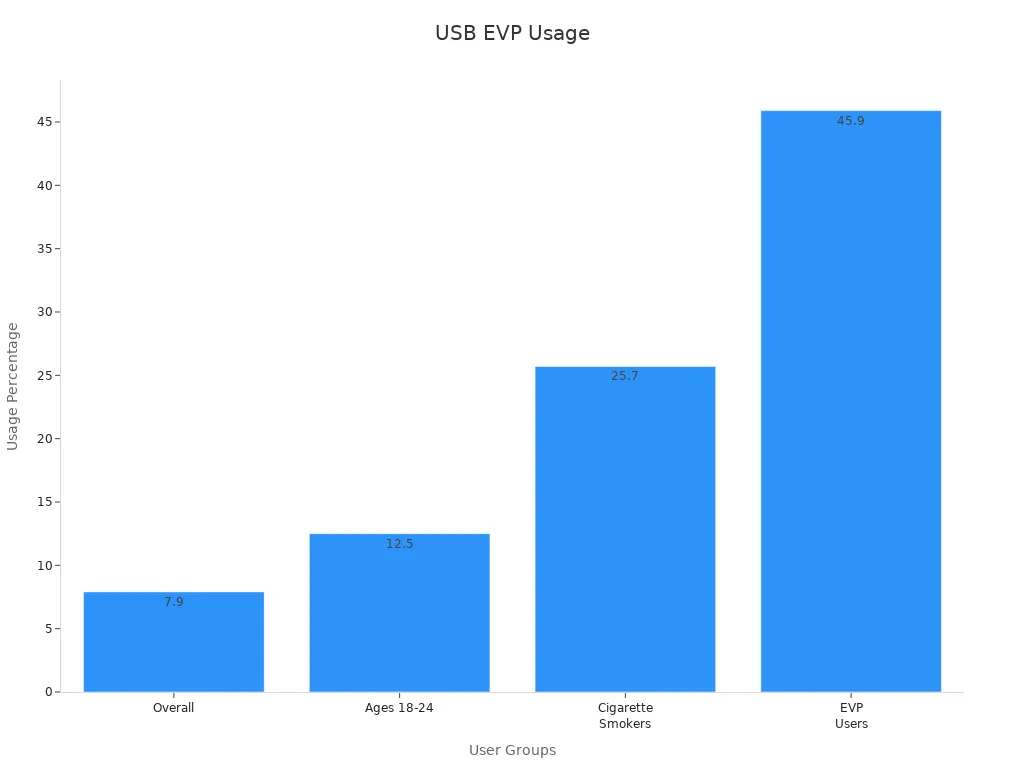
You can see that usb flash drives serve many groups and purposes. Their small size and ease of use make them a top choice for quick file transfers and temporary storage. If you need to carry files safely and quickly, a usb flash drive is a smart pick.
External Hard Drive
External Hard Drive Basics
An external hard drive lets you store lots of data easily. You connect it to your computer with a USB cable. There are two main types: HDD and SSD. HDDs have spinning disks inside. SSDs use flash memory and have no moving parts. You can use an external hard drive for backups or saving photos. It is also good for keeping music and videos safe. Many people pick these drives because they hold more than USB flash drives. Some models can store from 500GB up to 20TB. This makes them great for big files or full system backups.
Tip: To keep your files safe for years, choose a trusted external hard drive.
Features
External hard drives are known for their big storage and speed. You get more space for your money than with a USB flash drive. The table below shows how they compare to USB flash drives:
Feature | External Hard Drives (HDD & SSD) | USB Flash Drives |
|---|---|---|
Storage Capacity | Usually 500GB to 20TB; HDDs hold more; SSDs also available | Most are up to 1TB, but some rare ones are 2TB |
Speed | SSDs are fastest for big jobs; HDDs are slower | Faster than HDDs but not as fast as SSDs |
Technology | HDDs have moving parts; SSDs use flash memory | Use flash memory and have no moving parts |
Price per GB | HDDs cost less per GB; SSDs are faster but cost more | More expensive for each GB |
Durability | HDDs can break if dropped; SSDs are tougher | Tough because they have no moving parts |
External SSDs are the fastest choice. You can move big files quickly, which helps with videos or games. Most SSDs have cache memory to make them work better. Write caching is off by default, so you can unplug safely. If you turn it on, always eject your drive before unplugging. This keeps your data safe. Both HDDs and SSDs are plug-and-play, so you can use them right away.
Uses
You can use an external hard drive for many things. Backing up your computer is very common. Many people save photos, videos, and music on these drives. If you need to move big files, an external hard drive is helpful. External SSDs are good for editing videos or playing games because they are fast. You can also use these drives to keep files safe from computer crashes.
Common uses include:
Backing up your system
Saving big media files
Moving large projects between computers
Adding more storage to your computer
External hard drives are reliable, especially SSD models. HDDs have moving parts and can break if dropped. SSDs and flash drives handle shocks better. The chart below shows small drives lose data more often. Large drives are safer for long-term storage. If you unplug your drive the wrong way, you might lose data.
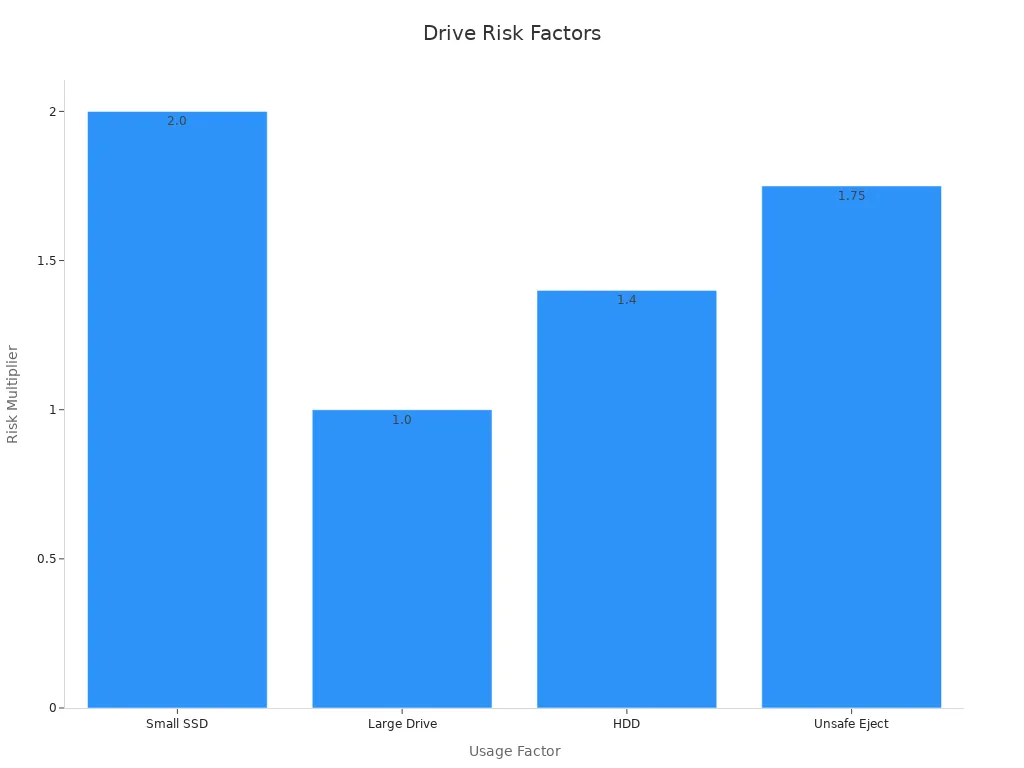
You get the best results by picking a bigger drive and always ejecting it safely. External hard drives are a smart and cheap way to keep your data safe.
Data Storage Comparison
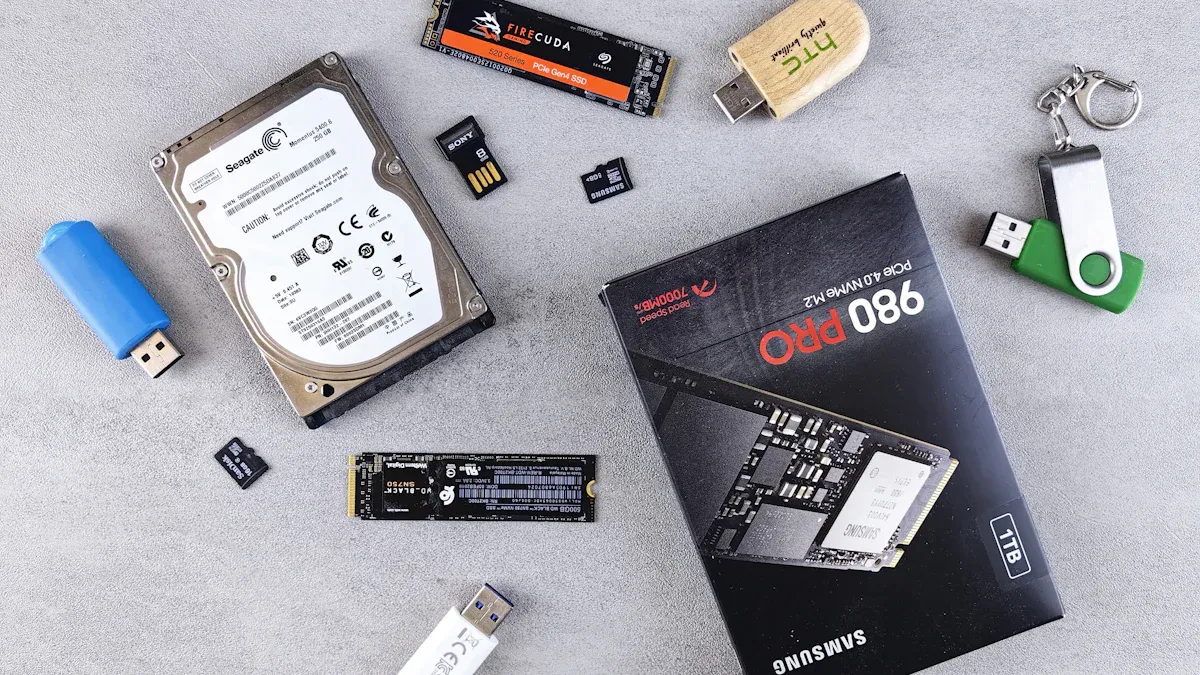
Portability
Size & Weight
When you compare a usb flash drive to an external hard drive, you notice a big difference in size and weight. A usb flash drive is tiny. You can hold it between your fingers or slip it into your pocket. Most models weigh less than an ounce. An external hard drive is larger and heavier. Some fit in your hand, but they still take up more space in your bag.
Here is a quick look at how different portable storage devices compare:
Device Type / Model | Transfer Speed (MB/s) | Drop Resistance | Durability Features | Notes on Portability and Usage |
|---|---|---|---|---|
Western Digital Elements Portable | ~110 (USB 3.0 HDD) | Desk height drops | Durable plastic-metal housing | Bulkier, mechanical HDD; slower speeds; large capacity; requires formatting for macOS; energy-efficient sleep mode |
SanDisk Extreme Portable SSD | Up to 1050 (NVMe SSD) | Up to 2 meters | IP55 water/dust resistance; rugged rubberized housing | Pocket-sized; very fast NVMe speeds; shock and water resistant; cross-platform exFAT format; premium price |
LaCie Rugged USB-C Portable HDD | Up to 5000 Mbps (5 Gbps USB-C) | Desk height drops; crush, dust, rain resistance | Military-grade durability; metal chassis with bumper | Large capacity; mechanical HDD; slower than SSDs; requires proper formatting on macOS; built-in encryption |
A usb flash drive is the most portable storage device you can carry. You do not need a cable. You just plug it in and go. An external hard drive often needs a cable and takes up more room.
Carrying Ease
You can attach a usb flash drive to your keychain or lanyard. It fits in your pocket or pencil case. You do not feel its weight. This makes it perfect for students or anyone who needs to move files quickly. An external hard drive is still portable, but you need to carry it in a bag or case. Some models have rugged cases for extra protection, but they add bulk.
Tip: If you want the easiest way to carry your files, choose a usb flash drive. If you need more space and do not mind a little extra weight, an external hard drive works well.
Storage Capacity
Typical Sizes
You need to think about storage capacity when you pick a data storage device. A usb flash drive usually comes in sizes from 2GB to 1TB. Most people use 16GB, 32GB, or 64GB models. These sizes are good for documents, photos, and small videos.
Capacity | Photos (10MP) | Songs (4 min MP3) | Office Files | Video Hours (1080p) |
|---|---|---|---|---|
2GB | 110 | 125 | 0.5GB | 5 mins |
4GB | 225 | 250 | 1GB | 10 mins |
250 | 500 | 2GB | 20 mins | |
16GB | 500 | 1,000 | 4GB | 40 mins |
32GB | 1,000 | 2,000 | 8GB | 80 mins |
64GB | 2,000 | 4,000 | 16GB | 160 mins |
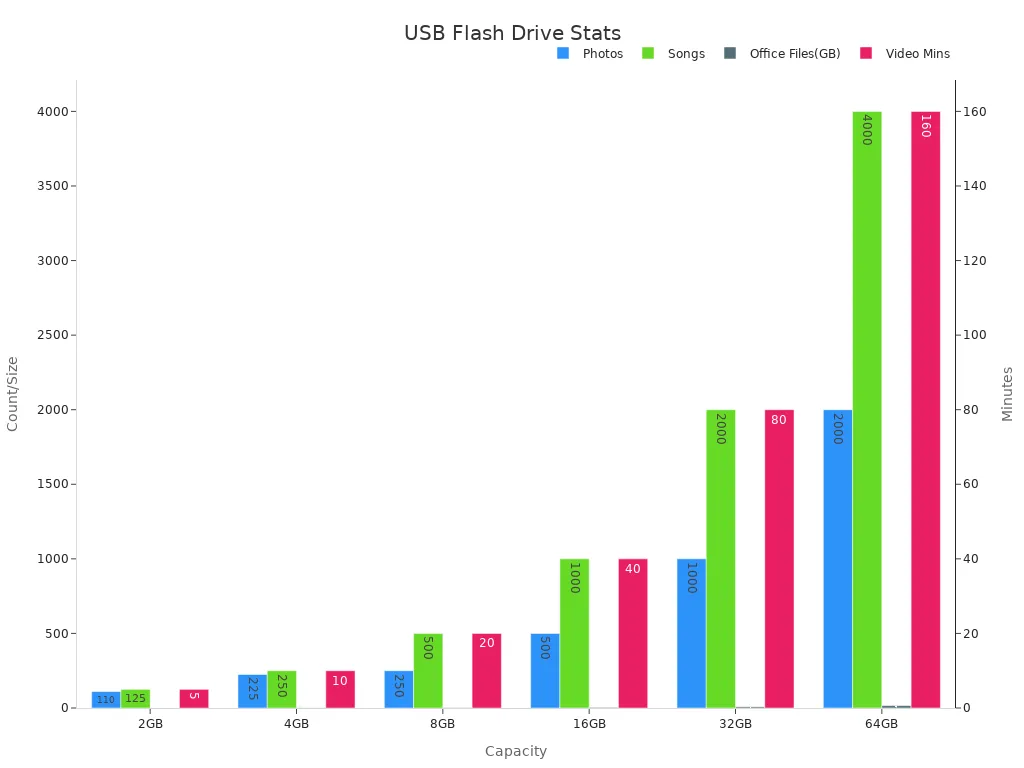
An external hard drive offers much more storage capacity. You can find models from 500GB up to 18TB. This is enough for thousands of photos, songs, and hours of video.
Capacity | Photos (12MP) | Songs (3MB each) | Video Minutes (1080p) |
|---|---|---|---|
8GB | 6,696 | 2,604 | 42 |
16GB | 13,393 | 5,208 | 84 |
32GB | 26,786 | 10,417 | 168 |
64GB | 53,571 | 20,833 | 336 |
128GB | 107,143 | 41,667 | 672 |
256GB | 214,286 | 83,333 | 1,344 |
512GB | 428,571 | 166,667 | 2,688 |
1TB | 857,143 | 333,333 | 5,376 |
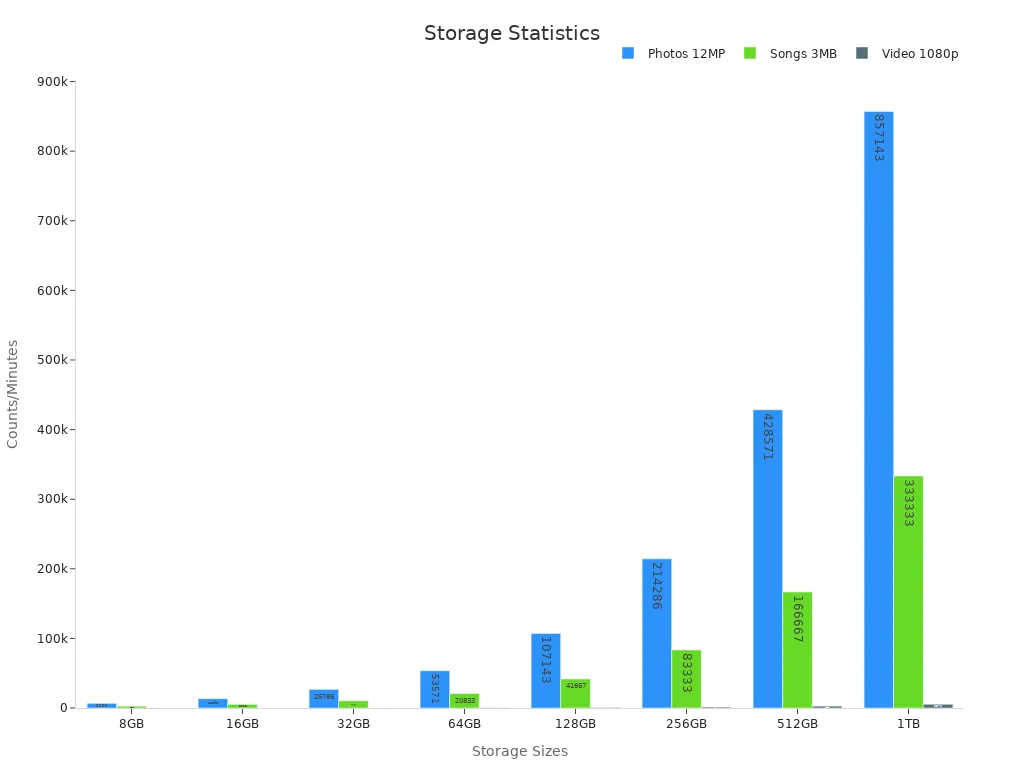
Expandability
You cannot expand the storage capacity of a usb flash drive. When you fill it up, you need to buy another one. An external hard drive gives you more space from the start. Some people use more than one external hard drive for even bigger data storage needs. If you want to back up your computer or store lots of videos, an external hard drive is the better choice.
Speed
Transfer Rates
Transfer speed matters when you move big files. A usb flash drive can have a wide range of speeds. Some models reach up to 1000 MB/s for reading, but many cheaper ones are much slower. Here is a look at some real world performance numbers:
USB Flash Drive Model | Read Speed (MB/s) | Write Speed (MB/s) |
|---|---|---|
~1000 | High (not specified) | |
ADATA SC610 500GB | 568 | 503 |
ADATA UC300 32GB | 130 | 19 |
ADATA UC300 64GB | 139 | 52 |
ADATA UC300 128GB | 101 | 64 |
ADATA UC300 256GB | 114 | 25 |
Verbatim V3 Drive 256GB | 269 | 79 |
Verbatim V3 Max 128GB | 417 | 151 |
An external hard drive with a spinning disk (HDD) usually has transfer speeds between 100 and 160 MB/s. External SSDs are much faster, often reaching 400 MB/s or more. Some top SSDs go over 1000 MB/s.
Storage Type | Typical Speed Range (MB/s) |
|---|---|
External Hard Drive (HDD) | |
USB Flash Drive | 20 - 400 |
External SSD | 400 - 3045 |
Performance
You get the fastest read or write performance from an external SSD. A usb flash drive can be fast, but only if you buy a high-end model. Most usb flash drives work well for small files and quick transfers. If you need to move large videos or back up your whole computer, an external hard drive or SSD gives you better performance.
Note: Data transfer speeds depend on the device, the USB port, and the cable you use. Always check the specs before you buy.
A usb flash drive is great for quick jobs and small files. An external hard drive is better for big tasks and lots of data storage. If you want the best real world performance, look for an external SSD.
Durability
Physical Strength
When you choose a usb flash drive, you get a device with no moving parts. This design gives it strong physical strength. You can drop it from your desk, and it will likely keep working. Many usb flash drives have tough plastic or metal cases. Some models even survive being stepped on or run through the wash. You do not need to worry much about breaking them during daily use.
An external hard drive, especially one with a spinning disk, has moving parts inside. If you drop it, the disk can get damaged. This damage may cause you to lose your files. Some external hard drives come with rubber bumpers or shock-proof cases. These features help, but they do not make the device as tough as a usb flash drive. If you want the best physical strength, look for an external SSD. These drives use flash memory, so they have no moving parts. They handle drops better than HDDs.
Damage Resistance
A usb flash drive resists damage from shocks, bumps, and even water in some cases. You can find models that are waterproof or dustproof. This makes them a good choice if you need to carry files in your pocket or bag every day. The durability of a usb flash drive means you can trust it for quick file transfers and daily use.
An external hard drive is more sensitive to drops and bumps. If you use an HDD, you must handle it with care. Even with a strong case, a hard hit can break the drive. External SSDs offer better damage resistance. They combine the large storage of an external hard drive with the longer lifespan and toughness of flash memory. If you want a device that lasts longer and stands up to rough handling, an external SSD or a rugged usb flash drive is your best bet.
Tip: For the longest lifespan and best durability, avoid dropping your devices and keep them away from water and dust.
Price
Cost per GB
You want to get the most storage for your money. The cost per gigabyte is much lower for an external hard drive than for a usb flash drive. Backblaze’s market data shows that in 2024, the average cost per gigabyte for a usb flash drive is about $0.085. For external hard drives, the cost is around $0.039 per gigabyte. This means you pay less for each gigabyte when you buy an external hard drive, especially if you need a lot of space.
Storage Type | Cost per Gigabyte (USD) | Notes |
|---|---|---|
USB Flash Drives (Flash Storage) | $0.085 (average, Sept 2024) | Flash prices dropped over 2024 after earlier spikes due to production throttling |
- TLC Flash | $0.11 | Highest flash subtype price in Feb 2024 |
- MLC Flash | $0.096 | Most numerous flash subtype |
- QLC Flash | $0.088 | High-capacity flash subtype |
External Hard Drives (Spinning Disk - SAS and SATA) | $0.039 (steady) | Prices stable, significantly lower than flash drives |
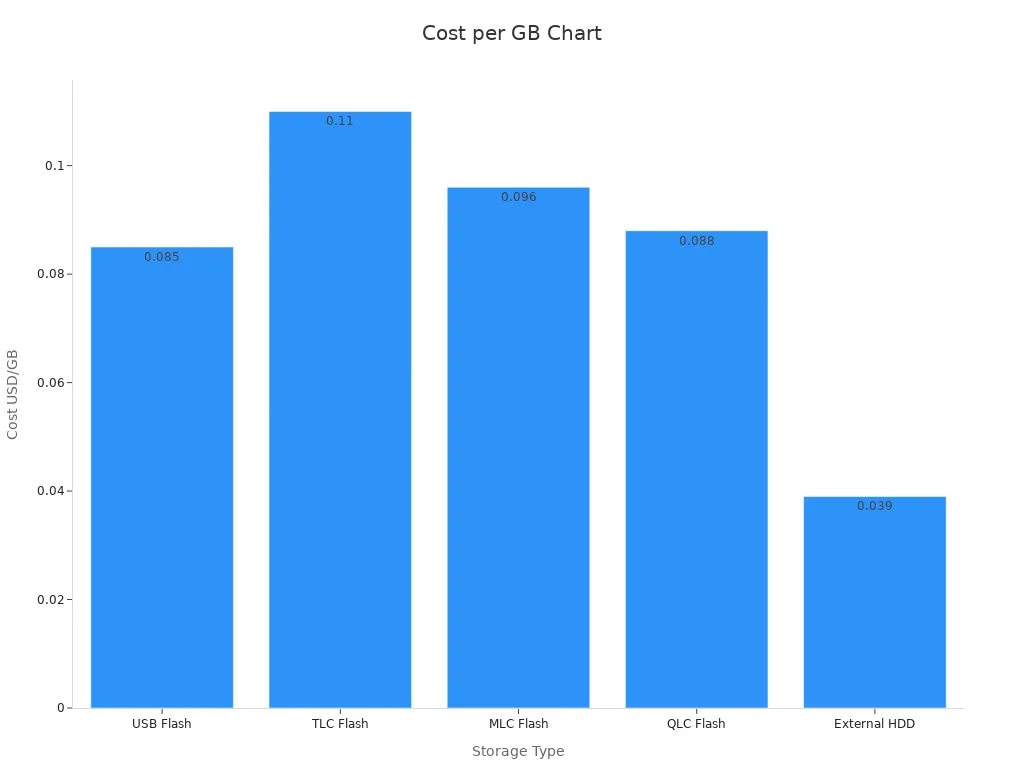
Value
You get more value from an external hard drive if you need to store lots of files. The lower cost per gigabyte means you can back up your computer or save large videos without spending much. A usb flash drive costs more for the same amount of storage. However, you pay for its small size and convenience. If you only need to move a few files or want something easy to carry, a usb flash drive gives you good value for those needs.
If you want the best value for long-term storage and backups, choose an external hard drive. If you want the best value for portability and quick transfers, a usb flash drive is a smart pick.
Security
Data Loss Risk
You must think about security when you use any data storage device. A usb flash drive is easy to lose because it is so small. If you lose it, someone else could access your files. The 2016 Verizon Data Breach Report found that usb devices are a top way for insiders to steal data. Companies use usb monitoring to stop this risk. If you use a usb flash drive, always keep it safe and consider using encryption.
An external hard drive is bigger, so it is harder to lose by accident. However, it can still be stolen or misplaced. Some attacks target external hard drives by changing their firmware. This can lead to data loss or even a security breach. You should use password protection or encryption to keep your files safe. Both devices can fail if you unplug them the wrong way or if they get damaged. Always back up your important files in more than one place.
Device Loss Risk
A usb flash drive fits in your pocket or on your keychain. This makes it easy to carry, but also easy to lose. If you drop it or forget it somewhere, someone else might find it and see your files. Many companies use physical controls like usb port locks to stop people from using unauthorized devices.
An external hard drive is larger, so you notice if it goes missing. Still, it can be stolen from your bag or desk. Recent reports show that both usb flash drives and external hard drives have been used in data breaches and ransomware attacks. You can lower your risk by using encryption, keeping your devices in safe places, and following good security habits.
Note: Always use strong passwords and keep your devices in secure locations to protect your data.
Use Cases
Backups
You want to keep your important files safe. An external hard drive is a strong choice for backups. It gives you a lot of space, so you can save photos, videos, and even full system images. Many people trust external hard drives because they last a long time. For example, some models show a failure rate of less than 1% per year, even after years of use. This means you can rely on them for regular backups. If you ever lose data, recovery rates are high, which adds another layer of safety.
A usb flash drive can also help with backups, but it works best for smaller jobs. You might use one to save a few documents or school projects. Flash drives are easy to carry, so you can keep a copy of your files with you. However, they do not offer as much space as an external hard drive. For big backups, you will need more than one flash drive or a larger device.
Tip: Use an external hard drive for full computer backups. Use a usb flash drive for quick copies of your most important files.
File Transfers
When you need to move files between computers, both devices can help. A usb flash drive is perfect for quick transfers. You just plug it in, copy your files, and go. It fits in your pocket, so you can take it anywhere. This makes it great for sharing photos, music, or homework.
An external hard drive is better for moving large files or many files at once. If you work with videos or big projects, you will notice the speed difference. The type of file system you use can also affect how fast your files move. For example, NTFS and exFAT file systems can make transfers up to 40% faster for small files compared to older systems like FAT32.
File System | Best For | Speed Improvement |
|---|---|---|
NTFS | Small files, random access | Up to 40% |
exFAT | Medium files | Up to 9% |
FAT32 | Large files | Up to 11% |
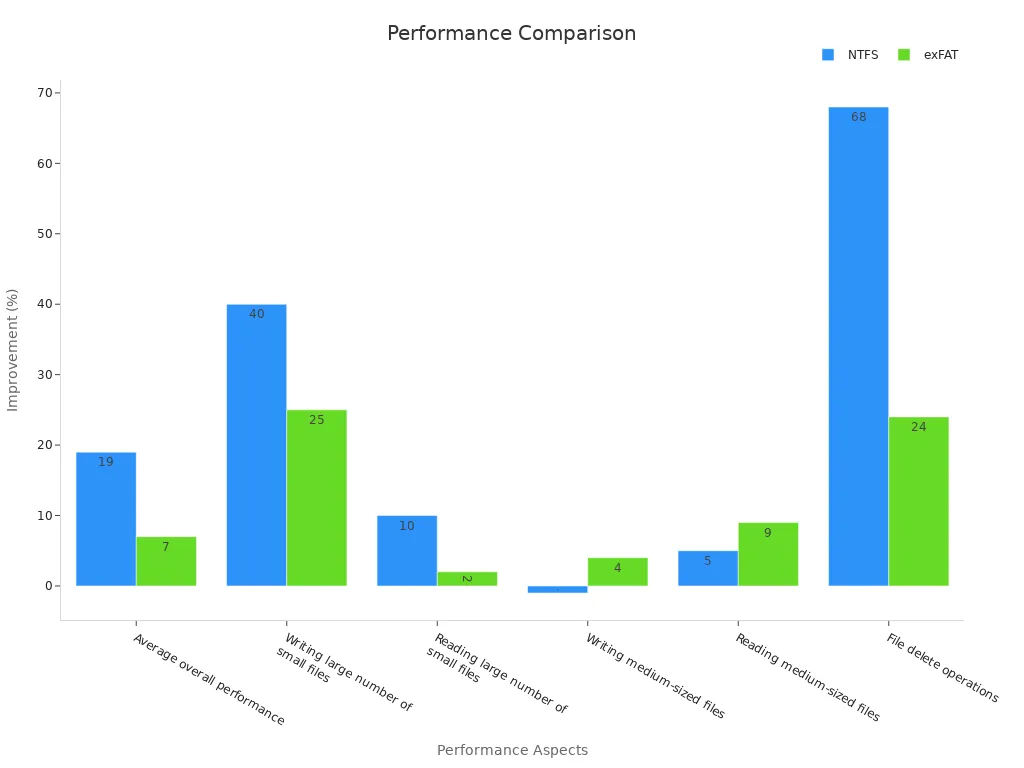
If you want the fastest transfers, use a modern file system and a high-speed device. For everyday tasks, a usb flash drive is quick and easy. For big jobs, an external hard drive saves you time.
Everyday Storage
You use storage devices every day for many reasons. The external hard drive is popular for storing large collections of photos, videos, and games. Many people choose it because it offers a lot of space for a good price. The market for external hard drives keeps growing as more people need to save big files at home and at work.
A usb flash drive is still a favorite for personal and small business use. You might use one to keep important documents, class notes, or music. Flash drives are easy to use and affordable. You can find them in many stores, and they work with almost any computer.
The storage market is growing fast because people need more space for digital files.
External hard drives are common for backups and archiving.
SSDs are getting more popular for speed and durability.
Usb flash drives stay in demand for their size and price.
You can use both devices with laptops, desktops, and even game consoles. Many people use storage sizes below 5TB for daily needs. If you need more space, you can always add another external hard drive or pick a bigger one.
Note: Choose the device that fits your daily habits. For lots of files, pick an external hard drive. For quick access and easy carrying, a usb flash drive is a smart choice.
Best for Specific Users
Students
Students need a storage device that fits their busy lives. A USB flash drive is small and light. You can clip it to your backpack or keys. It is easy to carry between classes or labs. You will not lose it if you keep it close. A flash drive helps you save homework and projects. You can use it on any school computer. It is simple to print or share files with friends.
Tip: Pick a USB flash drive with at least 32GB. This size holds documents, photos, and some videos.
Professionals
Professionals work with important files every day. You might work at home, in the office, or while traveling. An external hard drive gives you lots of space and fast speed. Many people use external SSDs because they are quick and safe. You can store big files like reports or designs. You do not have to worry about running out of room. If you have private files, choose a drive with password protection or encryption.
A study found people pick devices based on their work needs. Professionals often use desktops or laptops for better work. You should choose a storage device that matches your job and keeps files safe.
Creatives
Creatives make big files like photos, videos, and music. These files take up a lot of space. An external hard drive, especially an SSD, is best for you. SSDs are fast, so editing videos or moving photos is easier. Many creatives use drives with 1TB or more. This lets you keep all your work in one place. You can use a USB flash drive to share or move files quickly. But you need an external hard drive for main storage.
User Type | Best Device | Why It Works |
|---|---|---|
Students | USB Flash Drive | Portable, easy to use, affordable |
Professionals | External Hard Drive | Large capacity, secure, reliable |
Creatives | External SSD | Fast, high capacity, durable |
Gamers | External SSD/HDD | Space for games, fast load times |
Gamers
Gamers want to store many games and play fast. An external SSD gives you quick load times and lots of space. You can plug it into a console or gaming laptop. This helps you add more games easily. Some gamers use HDDs for old games or backups. SSDs are better for speed. You can use a USB flash drive for save files or small games. But it will not hold all your games.
Note: Always check if your device works with your new storage drive. Some consoles and computers need special formats or connections.
Decision Guide
How to Choose
You want to pick the right storage device for your needs. Follow these steps to make a smart choice:
Decide what you need most.
Do you want to carry files in your pocket, or do you need lots of space for backups? If you need something small and easy to use, a usb flash drive works well. If you want to store big files or back up your computer, an external hard drive is better.Check the speed and performance.
Look at the transfer speeds. External SSDs give you the fastest speeds. HDDs are slower but offer more space for less money. USB 3.0 and 3.2 flash drives can be fast, but high-end external SSDs are even faster.Think about durability.
If you need a device that can handle drops or bumps, choose a solid-state option. Both usb flash drives and external SSDs have no moving parts, so they resist shocks. HDDs are more fragile.Compare prices and value.
External hard drives give you more storage for your money. Flash drives cost more per gigabyte but win on portability.Test and maintain your device.
Use tools like EaseUS Partition Master to check the speed and health of your storage. Run tests for read/write speeds and look for errors. This helps you keep your device working well.
Tip: Always back up your important files, no matter which device you choose.
Pros & Cons
Here is a quick look at the main pros and cons for each device:
Device | Pros | Cons |
|---|---|---|
USB Flash Drive | - Ultra-portable and lightweight | - Limited storage size |
External Hard Drive | - Large storage capacity | - Bulkier and heavier |
USB flash drives give you easy file transfers and strong durability. You can use them on almost any computer. They fit in your pocket or on your keychain.
External hard drives offer more space and faster speeds for big jobs. You can use them for backups, media libraries, and large projects. SSD models are tough and quick, while HDDs are best for saving money on lots of storage.
Note: Experts say you should match your choice to your main use case. If you move files often and need something small, pick a usb flash drive. If you want to store lots of data or back up your system, choose an external hard drive.
You have two strong options for storing your files. External hard drives give you more space, faster speeds, and longer life. They work best for backups and large files. USB flash drives fit in your pocket and make quick transfers easy. They are great for small files and daily use.
Choose an external hard drive if you need lots of storage and reliability.
Pick a USB flash drive for portability and simple file sharing.
Think about what matters most to you—space, speed, or size. Both choices can fit your needs.
FAQ
What is the main difference between a USB flash drive and an external hard drive?
A USB flash drive is small and easy to carry. An external hard drive gives you more storage space. You use a flash drive for quick file transfers. You use an external hard drive for backups and large files.
Can I use both devices with Mac and Windows computers?
Yes, you can use both devices with Mac and Windows. You may need to format the drive to a compatible file system like exFAT. This lets you move files between both systems easily.
Which device is safer for long-term storage?
An external hard drive, especially an SSD, is safer for long-term storage. It holds more data and lasts longer. Always keep a backup of your important files in more than one place.
How do I protect my files if I lose my USB flash drive?
You can use password protection or encryption software. This keeps your files safe if someone finds your lost drive. Always keep your device in a secure place.
Can I run programs or games from these devices?
Yes, you can run portable programs from a USB flash drive. For large programs or games, use an external SSD for better speed. HDDs work, but they load slower.
Do I need special software to use these devices?
No, you do not need special software. Both devices work with most computers right away. You may use backup or encryption tools for extra features.
How do I know when to replace my storage device?
Replace your device if you see errors, slow speeds, or if it disconnects often. Test your device with tools like CrystalDiskMark. Always back up your files before the device fails.
What should I do if my external hard drive is not recognized?
Try a different USB port or cable. Restart your computer. If it still does not work, check the drive in Disk Management (Windows) or Disk Utility (Mac). Seek help if you cannot fix the problem.
See Also
Comparing eMMC, SSD, And HDD For Best Storage Value
Speed And Performance Differences Between eMMC And SSD
Three Key Differences Between USB-C And Traditional USB
